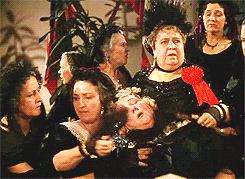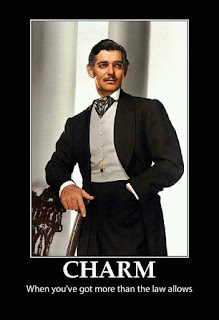When I think of Mrs. Ashley Wilkes (aka Melanie or “Ms. Mellie”),
I akin her with friendship. Have you ever had THAT friend? You know the one,
the friend who doesn’t judge you (even when you probably deserve it). They’re almost
miraculously oblivious to your flaws and somehow think you’re the moon and the
stars. I happen to be blessed enough to have one just like that and it’s
an extremely special thing... my “bestie” reminds me so much of Ms. Melanie
because not only does she NOT have a malicious bone in her body but she also
has that special something that makes people respect and look up to her because
there is such an abundance of innate goodness. She leads in a quiet, almost
demure way. That’s the thing about Melanie (and my bestie too in fact), you
just can’t help but like her.
The first time I watched Gone with the Wind and for a long time
thereafter, I will admit that I thought of Melanie as a doormat. I would roll
my eyes just waiting for the vivacious and sassy Scarlett to come back on the
scene. My longtime obsession with this movie kept reinforcing this opinion...
My thought process was that Melanie HAD to know what’s going on….her
sister-in-law (because remember, Scarlet married Melanie’s brother) is in love
with HER man, how could she NOT KNOW?! Scarlett, the woman who can have
any man on the hemisphere, a woman who will steal her own sister’s longtime
beau, a woman who (gasp) drives her own buggy and runs her own business, is
after HER man, everyone knows it, how can’t she?? She not only puts up with
Scarlett, but she’s STILL her friend, and a good one at that. . .that was my
perception of Melanie... that is until I read the book, and in doing so, I
discovered what I now think of as Melanie’s “silent strength”. It takes an
enormously strong woman to trust not only her husband but also her best friend.
Yes, she suspects what’s going on, but at the end of the day, she trusts them
both. Now that’s strength.
Think about it, who thinks on her feet when Scarlett kills that Yankee
solider who breaks in? She literally gives Scarlett the nightgown off her back
to wipe up the blood and helps her conceal the murder.... Who has a baby even
though it is clear that health-wise it probably isn’t a good idea? Who goes
against society and not only is kind to Belle Watling, but takes her
contribution? Who makes the final call about that controversial auction? Who
convinces Rhett to let them bury Bonnie? And who thinks on her feet again when
the police are after the gentlemen for going after Scarlett’s attacker?
Melanie. ALLLL Melanie!!! She’s actually quite a strong women, but in typical
Melanie form, you wouldn't know it because she just never makes a fuss.
That’s the thing about Gone with the Wind, there’s many layers
and ways to looks at it. Most think of it as a love story/romantic drama but I
have grown to think of it more as a movie about friendship. When you really
think of it, the men are in and out of the story, they’re bootlegging, in
prison, at war, or they've passed away but Melanie and Scarlett, they’re the constants. The movie
makes out like Ms. Scarlett is the heroine with her grand declaring of “I’ll
never be hungry again,” but I’m just going to say it, once I read the book, I
discovered that Melanie is the one to be revered.
I would be remiss not to talk about the amazing actress who played
her in the movie, Olivia de Havilland. Olivia got an Oscar nod as Best Actress
in a Supporting Role for her portrayal but not the win, she DID go on to win
Best Actress in a Leading Role for both The Heiress and The Snake Pit. If you
are a stitcher and have not seen The Heiress, I highly recommend seeking it out
as needlework does play a part (although small) in this drama (and FYI this has
been colorized so if you hate black and white movies, this may be an option). And
in 2017 Ms. de Havilland was made a Dame as she was awarded Dame Commander, Order of the British Empire, by Queen Elizabeth. I mean we always knew she was a classy lady and that was evident in her portrayal of Melanie. As I post, Ms. de Havilland is the only surviving member of the cast
and today just so happens to be her 104th birthday (and no, that
number is NOT a type-o, 104!!!). Ms. de Havilland, I wish you the happiest of
birthdays. . . and with that, HOW are we going to do this justice on our canvas??
Even though Melanie is plainer than Scarlett, Melanie’s still a leader in
society and the moral compass of what’s in good taste, so we need to treat her
as such. When you look at the reference photo (above), that bow is bigger than I am
willing to go for scale’s sake. . .So
many details to think about! I mean no pressure, right??
 This pink gown just screams for silk and because the shades
match so well, I’m using three of my favorite brands. Splendor S824, Planet
Earth 6 ply silk in Romance 1017, and Soie Cristale color 2031 and as I usually
do, I’m using three strands of each. Now I know a lot of you really like to completely cover the canvas, but as I’ve stated before, there’s a time and place for that
and then there’s a time to let the wonderful painting peak through and do the
work -- this is one of those times.
This pink gown just screams for silk and because the shades
match so well, I’m using three of my favorite brands. Splendor S824, Planet
Earth 6 ply silk in Romance 1017, and Soie Cristale color 2031 and as I usually
do, I’m using three strands of each. Now I know a lot of you really like to completely cover the canvas, but as I’ve stated before, there’s a time and place for that
and then there’s a time to let the wonderful painting peak through and do the
work -- this is one of those times.
Since I already had a few ideas for the bodice, I decided to
start with the skirt, but as I often do, there were a few false starts as far
as stitches were concerned. I tried a few different darning patterns all of
which didn’t work out for one reason or another. They looked too stripy, looked too much like what we did for Scarlett's or it
was too difficult to follow the shading. In the end, Parisian stitch ended up
giving just enough coverage, seemed to follow the drape of the skirt and
worked for the areas that needed shading. For the corset area of the
bodice, I used a stitch called Damask. All of these stitches are from
“Stitches to Go.” Funny thing about the name of this stitch—the book has TWO Damask
stitches and I just so happened to use both. For the area of as the bodice, I used
the Damask stitch at the top of the page which reminds me of arrows. I am in the
habit of taking a close-up photo of areas before I begin an area to use as
reference, you will see why this comes in
handy. I stitched right over the lines depicting the darting/corseting and will
need my reference photo to gauge where to put the lines back in. As I’ve
mentioned before, Fidelis creates the most incredible tassels so she has an
extensive collection of gimp for covering tassel heads and she just so happened to have the perfect color -- I just love when that happens! Gimp is so striking when couched down, especially with clear thread, so that’s
how I featured the darts/corseting. If you don’t have easy access to gimp like I do,
Painter’s thread has some pretty hand dyed versions but gimp is around, you
just have to look for it, you might have luck on Etsy if all else fails. I have
come to like it so much, I’ve started hoarding—I mean collecting—it when I see
it in my travels.
And let's look at our progress of Melanie thus far:
In our next episode we’ll continue working on Melanie. . .possibly doing something fun with the hair. . .and not to be coy, but just wait
until you see what we have planned for that fan! In the meantime, I hope we all
channel the spirit of Ms. Mellie by being sweet and kind to each other.





































